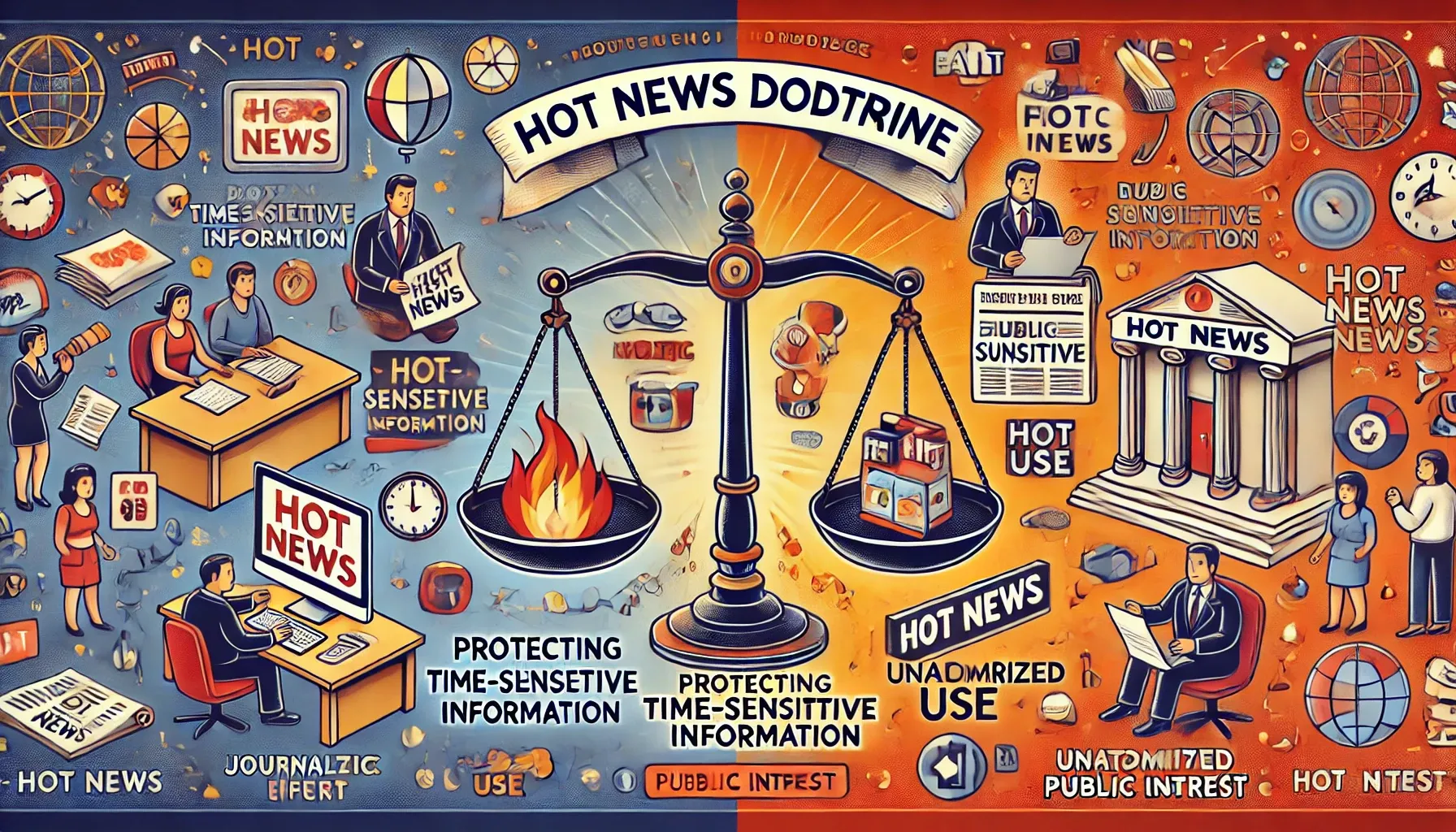The Hot News Doctrine protects time-sensitive information like breaking news or live sports updates from unauthorized use. While recognized in the U.S. under cases like NBA v. Motorola, its application in India relies on common law, facing challenges in a digital age.

Introduction
The Hot News Doctrine is a nuanced legal principle embedded in copyright and intellectual property law. It focuses on safeguarding time-sensitive information, such as breaking news, live sports updates, and other ephemeral facts that hold significant commercial value during a brief window. This doctrine aims to prevent the unauthorized commercial exploitation of such content, particularly when it undermines the investments made by those who diligently gather and disseminate the information.
Emerging in the United States, this doctrine has seen varied interpretations and applications across jurisdictions globally. This article explores its historical origins, its application in both the United States and India, and the challenges it faces amidst rapid technological advancements and evolving legal landscapes.
Origins of the Doctrine
The Hot News Doctrine finds its roots in the landmark U.S. Supreme Court case of International News Service v. Associated Press[1]. In this case, the court established a pivotal precedent by recognizing the quasi-property rights of news organizations over time-sensitive information. While the news as a fact was deemed non-copyrightable, its misappropriation for commercial benefit was categorized as unfair competition.
Justice Pitney underscored the significant resources and efforts invested by the Associated Press in news gathering. The ruling highlighted the necessity of protecting such endeavours from being exploited by competitors, such as the International News Service (INS). The principles established by this case include:
- News organizations are entitled to a quasi-property right in time-sensitive information they produce.
- The unauthorized commercial use of such information by competitors constitutes misappropriation.
- A balance must be struck between the public interest in accessing news and protecting journalistic effort.
The Doctrine in the United States
In the United States, the Hot News Doctrine operates within the nuanced framework of copyright law, particularly under the pre-emption provision of Section 301 of the Copyright Act[2]. While facts and ideas are inherently excluded from copyright protection, the doctrine offers limited safeguards in specific instances involving time-sensitive information. This protection aims to address situations where the unauthorized use of such information undermines the commercial value of the plaintiff's efforts in gathering and disseminating it.
A landmark case that defined the parameters of the doctrine was National Basketball Association (NBA) v. Motorola[3]. The NBA sued Motorola for providing real-time basketball scores through text messages without authorization. In its judgment, the court outlined a five-prong test to establish a valid hot news misappropriation claim. It required that the plaintiff bear significant costs in gathering the information, that the information be inherently time-sensitive, and that the defendant’s actions constitute free-riding on the plaintiff’s efforts. Furthermore, the defendant’s use must directly compete with the plaintiff’s business model, and the free-riding must pose a threat to the plaintiff’s ability to sustain its business operations. Despite this structured test, the court ruled in favour of Motorola, concluding that the NBA failed to satisfy all the criteria.
Another landmark case, Barclays Capital Inc. v. TheFlyOnTheWall.com[4], highlighted the challenges of applying the doctrine in the digital age. Barclays accused the defendant of disseminating its financial research without authorization. However, the court ruled in favour of TheFlyOnTheWall.com, reasoning that the rapid proliferation of news online diluted the applicability of the doctrine. The court emphasized the importance of fair use and competition, particularly in a digital era where information dissemination is instantaneous and widespread.
The application of the doctrine in the United States faces significant challenges. Plaintiffs often struggle to prove competitive harm and demonstrate how the defendant’s actions directly undermine their business model. Additionally, the rise of digital platforms complicates enforcement, as instantaneous news sharing blurs the line between legitimate reporting and misappropriation. Courts must also balance the protection of journalistic efforts with the broader principles of fair use and free competition, making the doctrine’s application increasingly limited and case-specific.
The Doctrine in India
In India, the Hot News Doctrine does not have formal statutory recognition and is instead addressed through common law principles. Indian courts often grapple with the complexities of copyright laws, which do not protect facts, while simultaneously addressing issues of unfair competition. Although not explicitly codified, the doctrine has been invoked in cases where unauthorized use of time-sensitive information is argued to constitute unfair trade practices.
In M/s Marksman Marketing Pvt. Ltd. v. Bharti Tele-Ventures Ltd.[5], mobile companies were restrained from disseminating live cricket scores and updates without proper authorization. The court recognized this as an instance of unfair trade practices, aligning with the essence of the Hot News Doctrine. Similarly, in Star India Pvt. Ltd. v. Piyush Agarwal & Ors.[6], Star India filed a claim against Cricbuzz and others for unauthorized live cricket updates. However, the Delhi High Court dismissed the applicability of the Hot News Doctrine, reasoning that news, once made public, cannot be copyrighted. Instead, the court focused on the doctrines of fair use and unjust enrichment to evaluate the claim.
The doctrine’s application in India faces several challenges. The absence of a statutory basis under Indian copyright law leaves the protection of time-sensitive information largely unaddressed. Additionally, the broad interpretation of the fair use doctrine often limits the scope for claims based on the Hot News Doctrine. Furthermore, practices such as paraphrasing and content aggregation by news platforms frequently bypass direct infringement claims, making enforcement more complex. As a result, while the doctrine holds conceptual relevance, its practical application remains constrained within the Indian legal framework.
Comparative Analysis
Conclusion
The Hot News Doctrine remains a critical yet evolving legal principle, especially in the era of digital media and instantaneous information dissemination. While the doctrine has found a foothold in the United States, its limited applicability and the challenges of enforcement highlight the need for updated legal frameworks. In India, the absence of statutory recognition further complicates its implementation, leaving courts to rely on common law and principles of equity.
As technology continues to redefine the boundaries of news sharing and consumption, revisiting and refining the Hot News Doctrine could ensure a balanced approach that protects the interests of content creators while fostering free competition and innovation.
[1] 248 U.S. 215 (1918).
[2] Section 301 of the Copyright Act of 1976 (U.S.).
[3] 105 F.3d 841 (2d Cir. 1997).
[4] 650 F.3d 876 (2d Cir. 2011).
[5] Marksman Marketing Services Pvt. Ltd. v Bharti Tele-Ventures Ltd. &Ors. O.A. No. 78/2006 (Madras High Court, Unreportable).
[6] C.S. (O.S.) No. 2722/2012, Delhi.
[7] Supra at 2.
[8] Supra at 3.
Download


